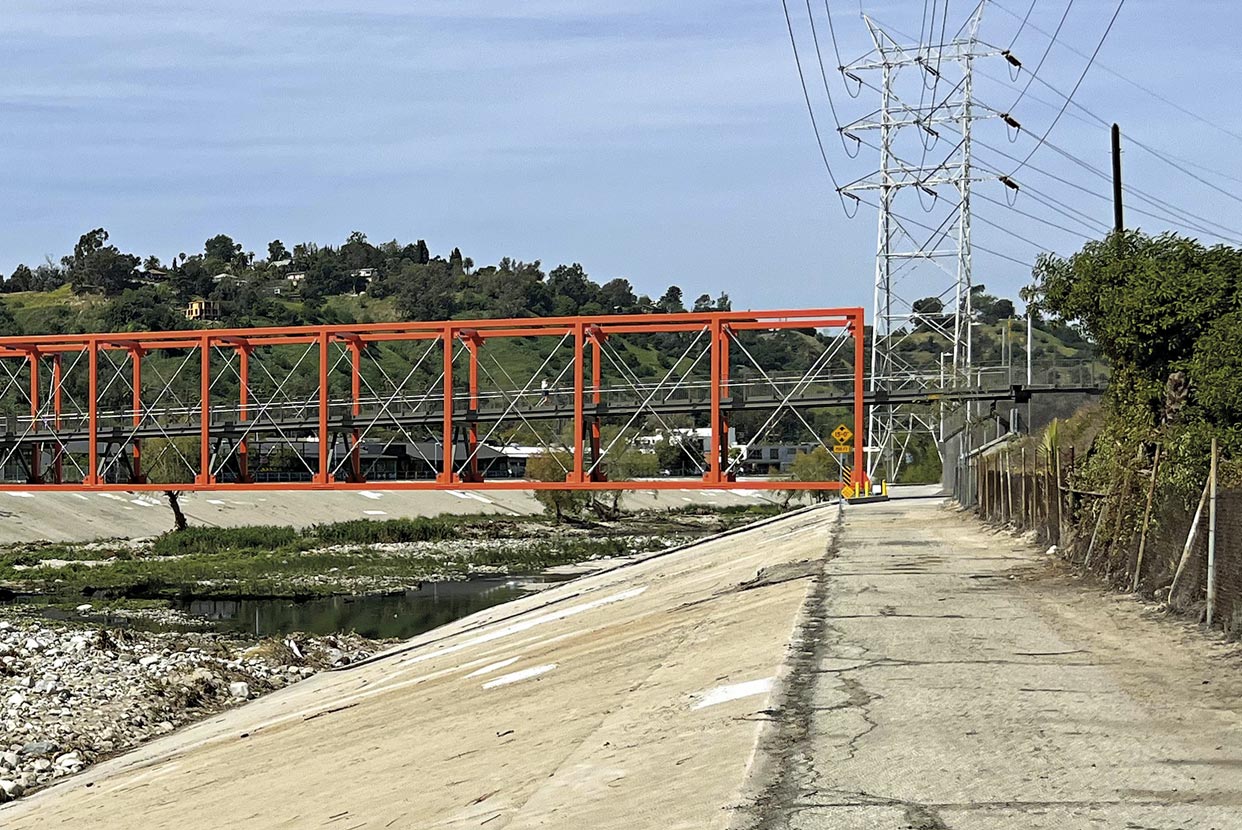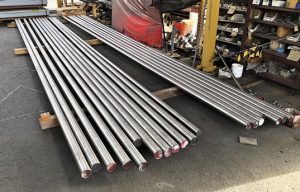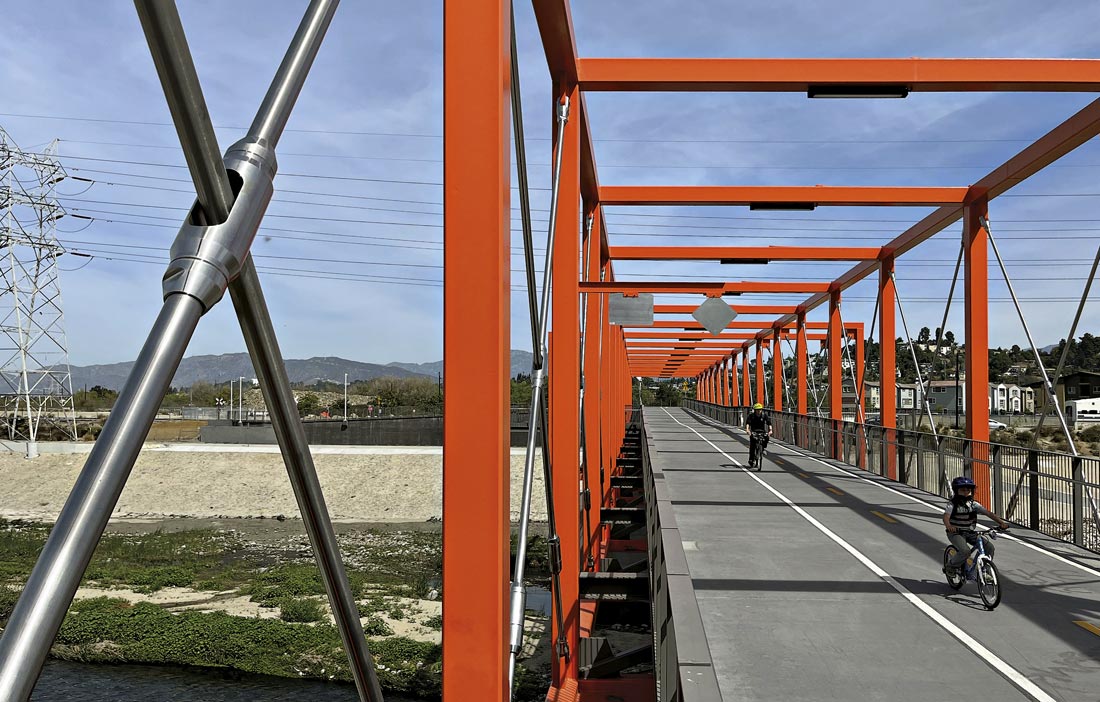
The Taylor Yard bridge showcases a stunningly simple and elegant design, achieved despite the complex constraints imposed by the site’s location. The bridge was designed by the architectural firm SPF:architects. Photo© Joe Linton
The Taylor Yard Bridge spans the Los Angeles River, reconnecting two neighborhoods long divided by geography and history. Its bold, oversized design, pays homage to the area’s industrial past as a bustling railyard and serves as a striking landmark. Slender 2205 duplex stainless steel tension rods provide the strength and resilience needed to hold this iconic structure together.
By Karlee Williston, Nickel Institute
The Taylor Yard Bridge, with its bold, 10-meter-high cubic tube outlined in bright orange, commands attention as it spans the Los Angeles River. Far more than a functional crossing, it symbolizes a massive effort to revitalize and naturalize the river. In the 1930s, the river was sealed with concrete to control flooding, leaving a paved canal that rigidly divided the communities along it’s banks.
A new way across
The section of the river where the bridge now stands was once home to the bustling Taylor Yard railyard on the north bank. Train bridges spanned the gritty river bed for about a decade, connecting the railyard to the larger network, until the rise of the US highway system in the mid-20th century shifted freight transport to trucks. By the 1950s, the abandoned railyard became a hotspot for fights and organized crime. The Taylor Yard Bridge’s bold orange color nods to the film Rumble Fish, where sparring orange beta fish symbolize conflict and tension in the story of two brothers caught in gang violence.
The 123-meter-long bridge, which opened in 2021, offers a rare pedestrian-focused crossing in one of the world’s most car-dependent cities. Traversing the bridge is a sensory experience, with views of the softening river ecosystem and the Santa Monica Mountains. Two cantilevered overlooks, positioned to follow the river’s natural curvature, invite visitors to pause and connect with the surroundings.
Overcoming initial design challenges

The river and now abandoned railyard posed significant geographical challenges for the design. Large powerlines and city ordinances limited the potential height of the construction, with a maintenance road and bike path on either side further restricting available build space. On top of these limitations, a 3 m elevation difference between the two concrete riverbanks added another layer of difficulty.
To address these constraints, the bridge employs a minimalist design using 36 cm square tubes for its main structure. This framework is reinforced by 2205 duplex stainless steel tension rods, which provide the necessary stiffness. This design allows the bridge to function as a single beam without the need for pylons or counterweights.
When viewed from the outside, the orange box carrying the deck remains level, cleverly concealing the 3-meter height difference between the riverbanks. Inside, the pathway slopes at a 3% grade, creating an illusion for those walking through the bridge, where the structure ahead seems to grow or shrink as the path appears to float through it.
Why designers chose 2205 duplex stainless steel
2205 duplex stainless steel with 3% molybdenum was chosen for the tension rods for its superior strength and corrosion resistance. While alloys like Type 316 stainless steel might have provided sufficient corrosion resistance, their lower strength would have required thicker, more obtrusive rods. The slimmer profile of 2205 ensures the tension rods blend seamlessly with the surroundings, without competing visually with the brightly painted superstructure.
The simple yet bold Taylor Yard Bridge has drawn attention from the design world for its striking and thoughtful design. While the bridge provides a vital pedestrian and cyclist crossing over the LA River, its connection to the larger bike path network is currently limited by unfinished segments in the surrounding area. Architect Zoltan Pali, the project’s principal designer, noted “in a little way, [the bridge] adds to the betterment of the communities, [and] to the ease of people being able to connect and interact with each other.”
The bridge stands as both a functional crossing and a symbol of LA ’s commitment to revitalizing the river and its communities.
About IMOA
Reproduced with the kind permission of the International Molybdenum Association (IMOA). IMOA is a non-profit trade association representing the majority of the molybdenum industry worldwide. For information visit www.imoa.info

The relatively thin and reflective tension rods allow for open views while crossing. Photo© Joe Linton
About this Tech Article
Appearing in the June 2025 issue of Stainless Steel World Magazine, this technical article is just one of many insightful articles we publish. Subscribe today to receive 10 issues a year, available monthly in print and digital formats. – SUBSCRIPTIONS TO OUR DIGITAL VERSION ARE NOW FREE.
Every week we share a new technical articles with our Stainless Steel community. Join us and let’s share your technical articles on Stainless Steel World online and in print.

